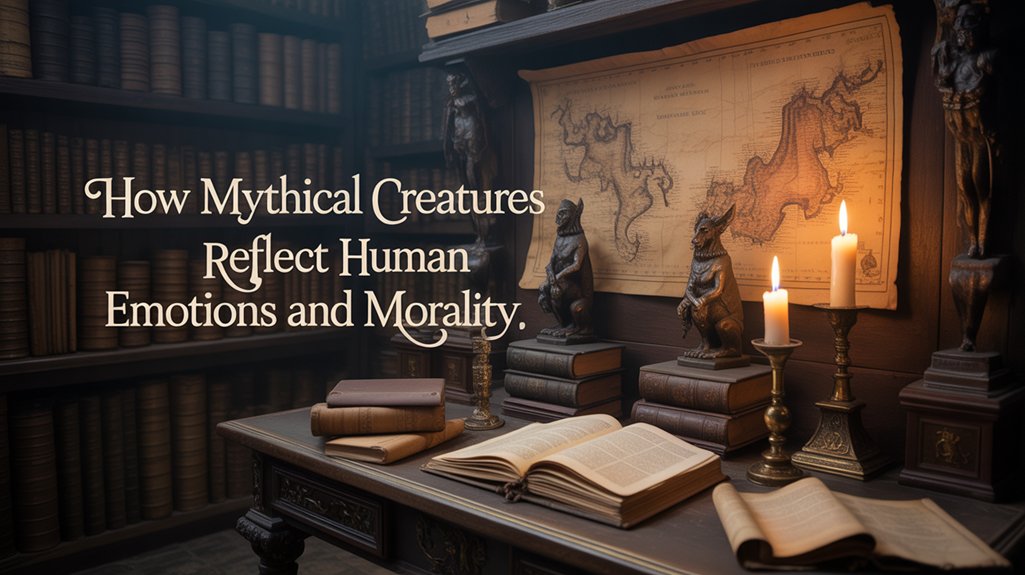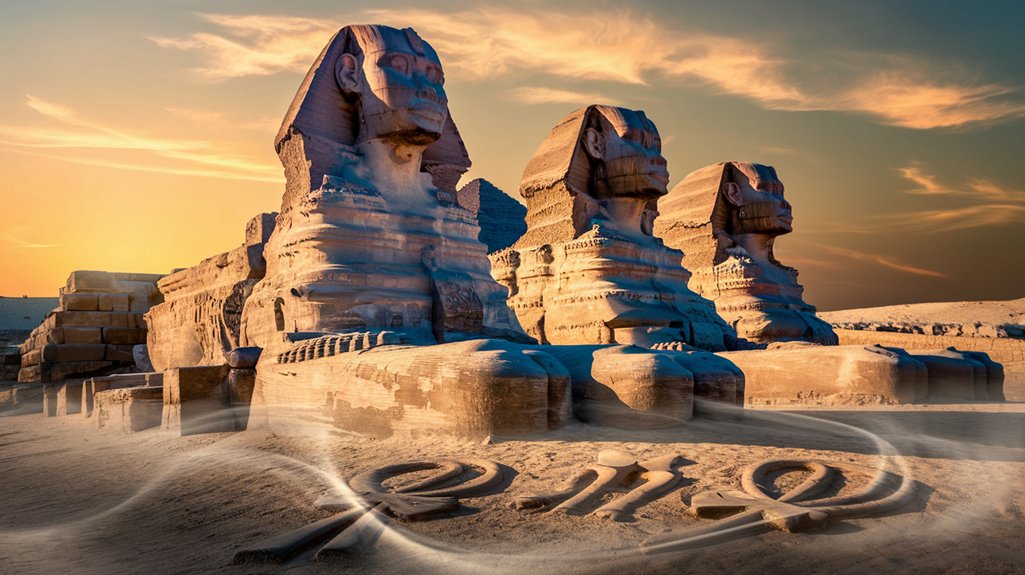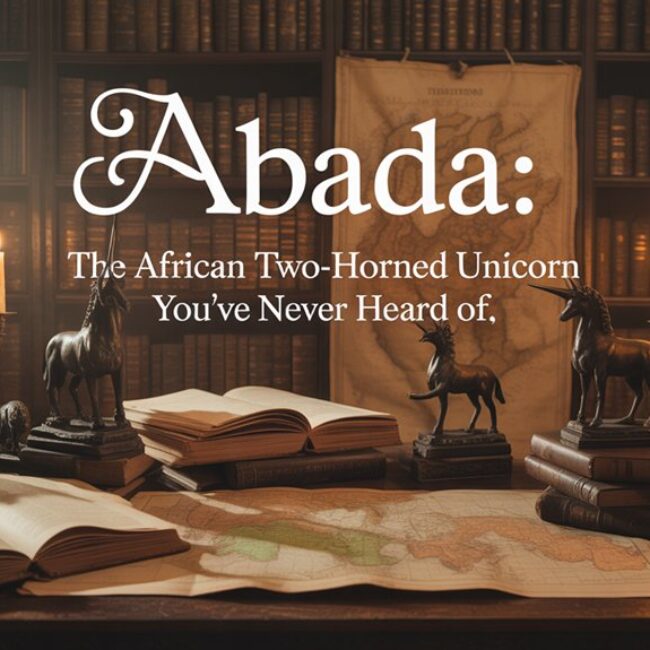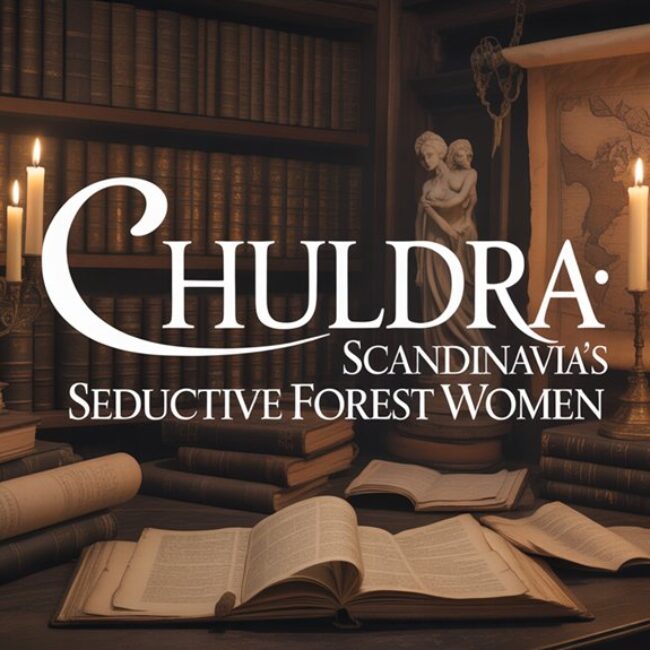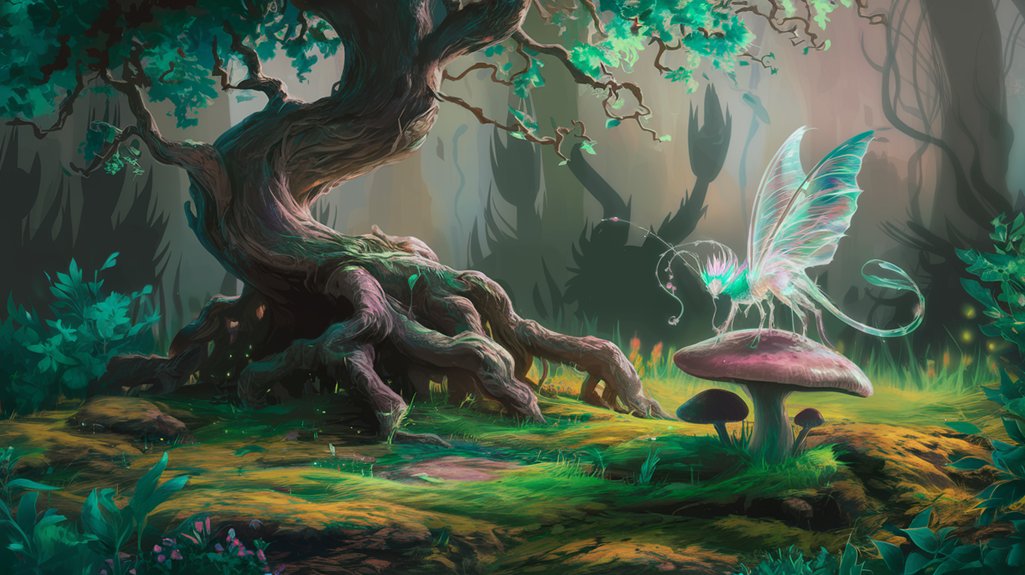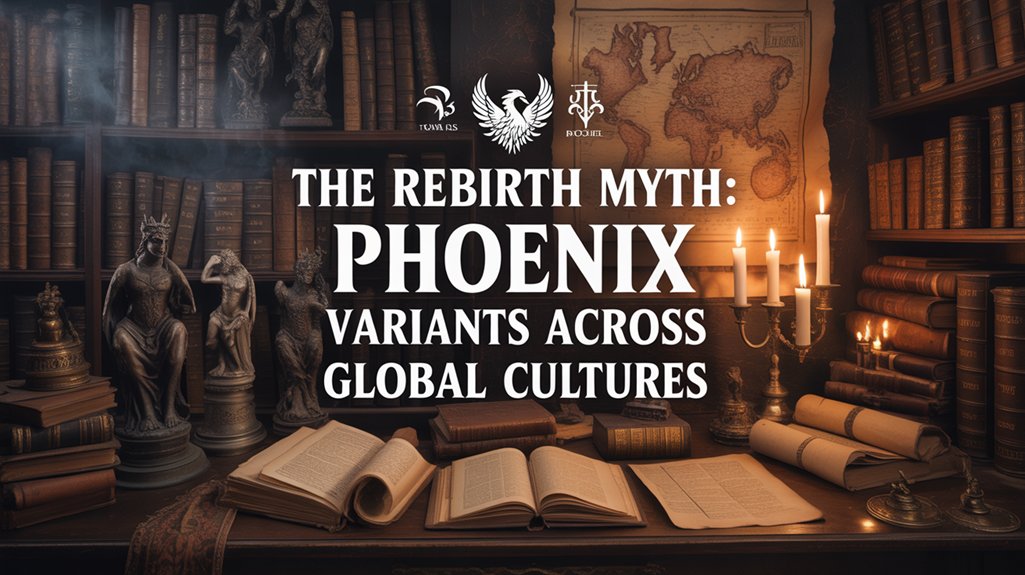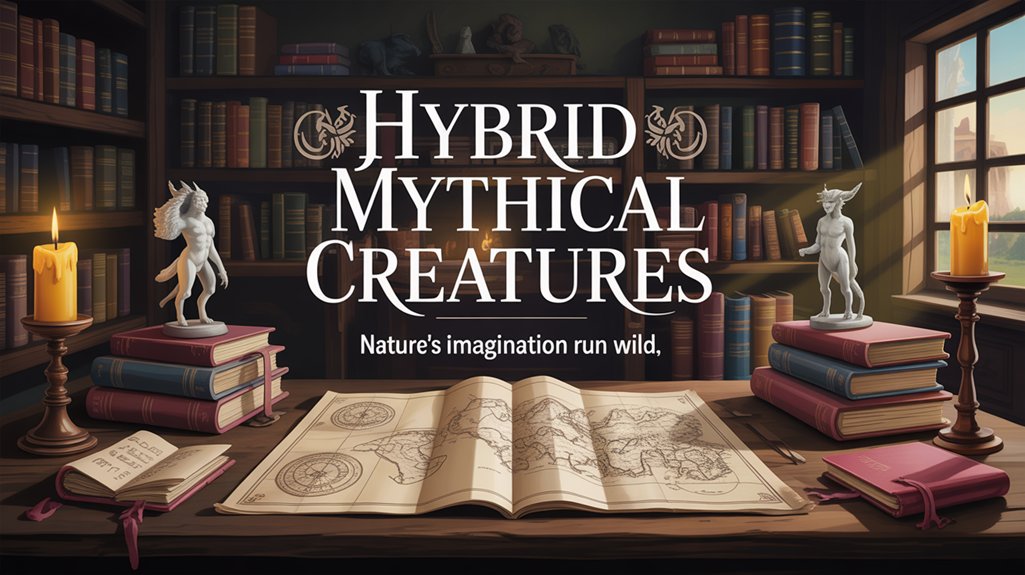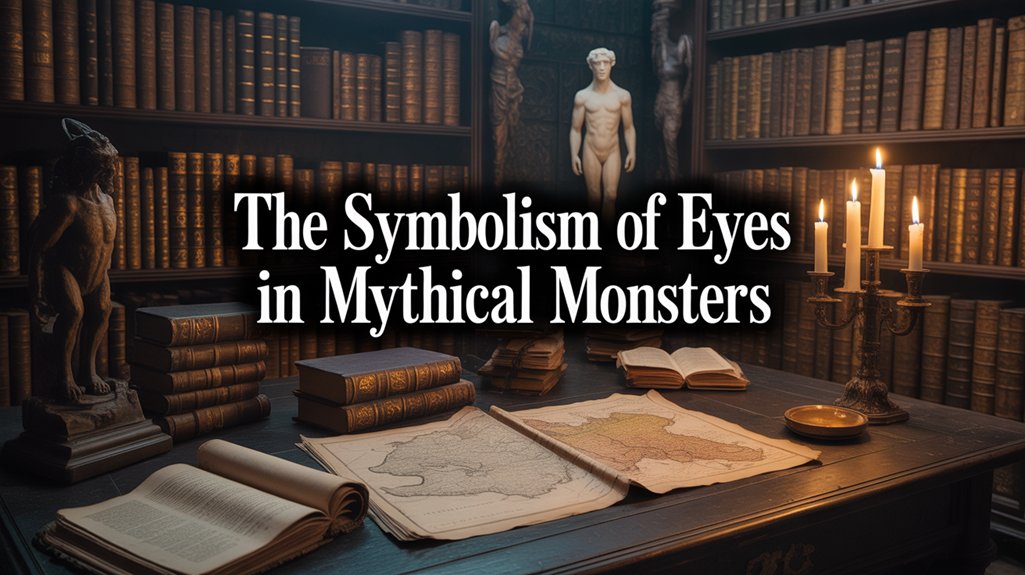
You’re witnessing humanity’s oldest psychological technology when encountering mythical creatures—these chimeric forms externalize your internal emotional architecture, altering abstract turmoil into tangible narratives. Dragons crystallize primal terror into confrontable forms, phoenixes embody transformation’s paradox after catastrophic loss, while sirens manifest the eternal conflict between desire and ethical duty. From Mesopotamian Enkidu’s untamed rage to Greek Furies compelling recognition of moral transgressions, these archetypal beings serve as emotional cartography across cultures. Contemporary neuroscience confirms that mythical encounters activate brain regions governing moral calculations, revealing how ancient wisdom anticipated modern therapeutic applications for processing your shadow-self.
Table of Contents
ToggleKey Takeaways
- Mythical creatures externalize complex emotions like fear, rage, and desire, transforming abstract psychological struggles into tangible narratives for exploration.
- Dragons, phoenixes, and chimeras crystallize primal anxieties and conflicting feelings, allowing humans to confront suppressed emotional elements through symbolic storytelling.
- Creatures like sirens and the Minotaur embody moral dilemmas between temptation and duty, illustrating ethical conflicts between instinct and expectation.
- Cross-cultural anger deities and flood myths reveal universal patterns of moral corruption and purification across civilizations.
- Modern therapeutic applications use mythical archetypes to name anxieties and process emotions, bridging ancient wisdom with contemporary psychological practice.
Emotions Mirrored in Myth

When ancient civilizations conjured their mythical pantheons from collective unconscious depths, they weren’t merely crafting entertainment—they were externalizing the turbulent emotional landscapes that define human existence.
Dragons manifest your primal fears, those eldritch anxieties gnawing at consciousness’s edge. The phoenix’s flames? Your life-changing potential. Each mythical symbolism carries profound emotional resonance that transcends temporal boundaries.
Consider the siren’s song—that chimeric blending of beauty and destruction mirrors your rational mind’s perpetual war against destructive desire. You’ve felt this tension.
The Minotaur, trapped within labyrinthine corridors, embodies the moral dilemmas you navigate between instinct and expectation, between freedom and constraint. Griffins stand sentinel over virtue’s threshold, representing your internal guardian against temptation’s seductive whispers.
These creatures weren’t fabrications. They were mirrors—polished bronze reflecting humanity’s psychological architecture back upon itself.
Through mythical symbolism, ancient peoples named the unnameable, gave form to formless emotional chaos, creating vessels for understanding the human condition’s complexity. The Chimera’s hybrid nature—blending lion, goat, and serpent into a single fire-breathing entity—symbolizes the chaos of conflicting emotions warring within your psyche.
##
When you encounter the scaled magnificence of dragons or the chimeric form of the griffin in ancient narratives, you witness humanity’s attempt to externalize what churns within—the eldritch terrors, the consuming desires, the perpetual oscillation between virtue and vice.
These creatures function as psychological vessels, their monstrous or divine attributes serving as tangible manifestations of emotions too complex, too overwhelming for direct articulation in Bronze Age assemblies or medieval courts.
Through their wings and fangs, their songs and flames, storytellers across Mesopotamian ziggurats and Hellenic temples altered abstract emotional warfare into concrete mythological flesh.
Mythical Creatures and the Expression of Human Emotions Through Storytelling
Throughout millennia of human storytelling, mythical creatures have served as profound vessels for emotional expression, transmuting ineffable inner experiences into tangible, archetypal forms that resonate across cultural boundaries.
You’ll discover that dragons externalize your deepest fears, their eldritch flames consuming the psychological barriers constraining authentic self-confrontation.
Phoenixes embody your yearning for renewal. These chimeric beings map emotional landscapes otherwise inaccessible through conventional discourse, allowing you to navigate longing, loss, and desire within fantasy’s protective framework.
Mermaids and sirens illuminate your internal conflict—rationality versus desire, safety versus passion. Through mythical symbolism, you engage subconscious territories where fears and aspirations dwell unexamined.
These archetypal figures transcend mere entertainment, functioning as psychological mirrors that reflect societal values while granting you freedom to explore moral complexity without judgment’s weight.
The Wendigo’s insatiable hunger exemplifies how mythical creatures embody humanity’s darkest impulses, transforming moral transgressions into cautionary tales that reinforce communal values and ethical boundaries.
Emotions Embodied in Creatures
Mythical creatures function as crystallized embodiments of singular emotional states, their anatomical impossibilities serving as visual lexicons for psychological complexities that resist verbal articulation.
Dragons manifest your primal terrors—those eldritch anxieties gnawing at consciousness’s foundations. The phoenix emerges from ash, bearing mythological symbolism of metamorphosis you crave when loss threatens annihilation.
Sirens embody desire’s chimeric nature, that space where rationality dissolves into temptation’s undertow. You recognize griffins as sentinels of virtue, their hybrid forms protecting what you hold sacred against moral corruption.
The Minotaur prowls the labyrinth between civilization and chaos, representing that internal battle you wage constantly.
These creature emotions aren’t metaphorical conveniences—they’re archetypal truths coded into humanity’s collective unconscious, granting you freedom to explore psychological territories language can’t adequately map.
Fear and Desire Personified
Because fear and desire occupy opposite poles of human motivation yet share identical neurological pathways, mythical creatures collapse this duality into singular, tangible forms that your psyche can finally confront.
Dragons embody fear representation—eldritch manifestations of terror that crystallize your anxieties into scales and flame, altering abstract dread into something you can name, visualize, challenge.
Sirens personify desire conflict, their voices weaving the eternal struggle between rational self-preservation and the chimeric allure of destructive cravings.
You recognize yourself in these ancient archetypes. The phoenix whispers of alteration’s possibility, while griffins stand sentinel against your basest impulses.
These creatures don’t merely symbolize psychological forces—they externalize the repressed elements of consciousness, granting you permission to examine what civilization demands you suppress, offering liberation through acknowledgment.
Moral Dilemmas in Myths
When heroes confront creatures stationed at moral crossroads, they encounter externalized manifestations of ethical paradox—beings that force immediate reckoning with principles civilization pretends are absolute.
The Minotaur’s labyrinthine prison mirrors humanity’s tangled relationship with primal urges, its chimeric form embodying moral ambiguity between beast and man.
Sirens don’t merely tempt—they illuminate the razor’s edge where desire wars against duty, where you’re stripped bare before your hungers.
Heracles’s Twelve Labors convert punishment into purification, each monstrous adversary representing internal corruption demanding confrontation.
These mythical lessons aren’t antiquated fables but eldritch mirrors reflecting your perpetual struggle.
The phoenix rising from ash whispers truths about evolution through failure.
Dragons guard not gold but self-knowledge, demanding you face overwhelming terror to claim sovereignty over your fractured soul.
Early Mesopotamian Emotion Deities
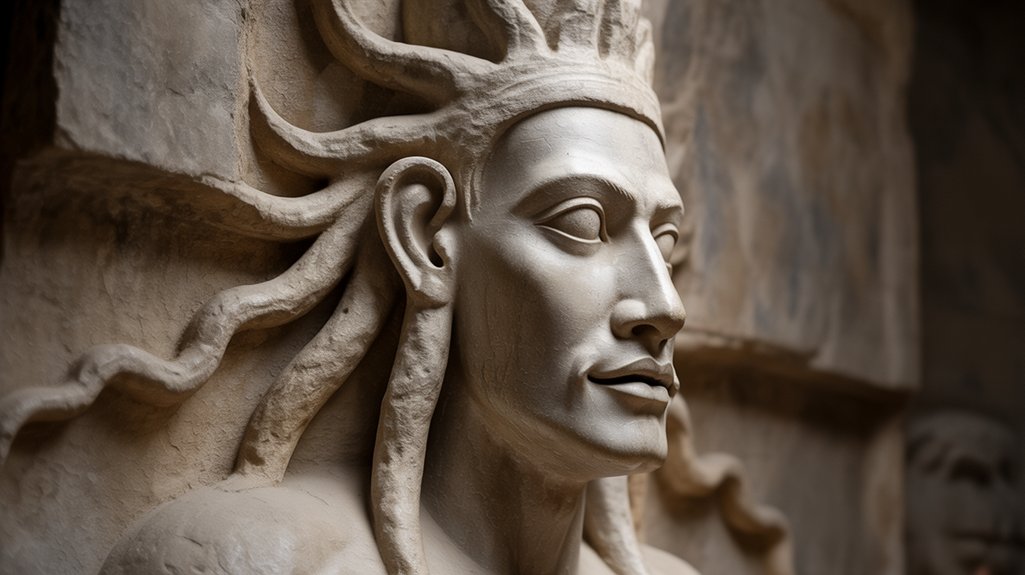
You’ll find the eldritch alteration of Gilgamesh’s companion Enkidu inscribed upon the ancient tablets of Uruk, where his primordial wrath—born of the Mesopotamian wilderness—becomes the epic’s most profound meditation on emotion’s divine architecture.
This wild man, fashioned from clay by the goddess Aruru, embodied humanity’s untamed rage until Shamhat’s sacred encounter initiated his change from beast to brother.
Within friendship’s alchemical crucible, Enkidu’s chimeric fury transmuted into loyalty, demonstrating how the Sumerians understood emotional bonds as forces potent enough to reshape the very essence of a being’s nature.
Gilgamesh Epic Enkidu’s Rage
Rage—primal, altering, divine—pulses through the clay-born form of Enkidu, the wild man fashioned by Aruru’s hands circa 2100 BCE to temper Gilgamesh’s tyrannical excesses in ancient Uruk.
You’ll find in this eldritch creation a mirror for humanity’s untamed self, unbound by civilization’s constraints. His metamorphosis from beast-companion to urban dweller charts emotion’s domestication, yet rage persists beneath courtly veneer.
When death claims him, that suppressed fury erupts through Gilgamesh’s grief—a chimeric blend of anger and anguish that shatters kingly composure. The gods orchestrated this emotional tempest deliberately, weaving mortal feelings into cosmic design.
Here stands humanity’s fundamental struggle: acknowledging raw emotion while seeking transcendence. Enkidu embodies freedom’s cost—civilization demands surrender of instinctual truth, yet his legacy proves authentic feeling can’t be forever chained.
Ancient Uruk and Mesopotamian Plains
Beneath the ziggurat shadows of Uruk circa 3000 BCE, the Mesopotamian pantheon breathed emotional architecture into human consciousness—deities who didn’t merely observe mortal feelings but incarnated them, transmuted them, weaponized them. You’ll discover divine influence manifesting through Inanna’s eldritch duality, embodying both ecstatic love and battlefield carnage, while Enki channeled wisdom’s fluid depths through primordial waters.
| Deity | Emotional Domain | Ritual Purpose |
|---|---|---|
| Inanna | Love/War | Fertility rites, battle blessings |
| Enki | Wisdom/Creation | Knowledge-seeking ceremonies |
Ancient rituals demanded offerings—incense, libations, hymns—to negotiate humanity’s chimeric nature. These Sumerian narratives weren’t mere mythology but psychological frameworks, establishing ethical boundaries through divine allegory. Passion unchecked bred catastrophe; ambition without wisdom courted doom. The pantheon’s emotional spectrum reflected society’s recognition that feelings required sacred architecture, divine containment, moral consequence.
Friendship Taming Primal Fury
When Enkidu first emerged from the wilderness—half-beast, half-human, embodying unchecked rage—the Epic of Gilgamesh crystallized Mesopotamia’s profound understanding that friendship alone possessed alchemical properties sufficient to change fury into purpose.
You’ll discover within these ancient tablets how friendship interactions between Gilgamesh and Enkidu established patterns echoed throughout emotion deities like Inanna and Ereshkigal, whose eldritch conflicts mirrored humanity’s internal struggles.
The chimeric nature of these relationships—simultaneously violent and tender—revealed emotional balance as civilization’s cornerstone.
Enki and Enlil’s collaborative mythology demonstrated how companionship restrains primal instincts, channeling destructive energies toward collective harmony.
Through loyalty and mutual respect, these divine narratives taught that true strength manifests not through dominance but through vulnerability, changing rage into wisdom, isolation into community.
Cross-Cultural Anger Manifestations

Across the vast expanse of human civilization, anger has crystallized into myriad forms—each culture sculpting its own chimeric embodiments of rage, each society breathing life into creatures that prowl the boundaries between acceptable fury and destructive wrath.
You’ll discover cross cultural comparisons reveal striking patterns: China’s dragons embody nature’s wrath tempered by wisdom, while Greece’s Furies personify vengeance’s moral weight. Mythological symbolism alters abstract emotion into tangible terror.
| Culture | Creature | Anger Manifestation |
|---|---|---|
| Norse | Jörmungandr | Environmental chaos from human transgression |
| Japanese | Tengu | Social discord through uncontrolled emotion |
| Greek | Minotaur | Internal violence consuming the self |
The serpent Jörmungandr coils around Midgard—eldritch guardian of natural order. Japan’s Tengu spirits patrol communal harmony’s edges. Each yokai whispers cautionary tales. The Minotaur’s labyrinth mirrors your psyche’s darkest corridors, where rage breeds monsters. These creatures demand balance, respect, restraint. They’re warning signals carved into collective memory.
Flood Myths as Moral Cleansing
Waters rise where anger festers unchecked—humanity’s collective transgressions accumulating until divine patience breaks like storm clouds over corrupted cities.
You’ll find flood symbolism threaded through ancient consciousness, from Mesopotamian tablets to Vedic scriptures, each deluge marking threshold moments when moral contamination demanded catastrophic purification.
Divine retribution manifests through these aqueous apocalypses, washing away the eldritch corruptions that chimeric civilizations spawned through hubris and depravity.
Floods cleanse civilizations when humanity’s arrogance breeds corruption beyond redemption—water becoming heaven’s instrument of moral purification.
These narratives reveal universal patterns:
- Gilgamesh’s deluge warns Utnapishtim alone, rewarding his obedience while drowning the wicked masses
- Noah’s survival demonstrates preparedness and faith against societal mockery
- Manu’s fish-guide preserves sacred knowledge through India’s primordial floods
- Cross-cultural persistence suggests shared ancestral memories of actual catastrophes altered into moral instruction
You’re witnessing humanity’s cyclical reckoning—each flood myth acknowledging our capacity for degradation while offering redemption’s possibility.
The waters recede. Survivors rebuild. Freedom emerges through accountability to something greater than temporal desires.
Greek Furies Punishing Wrongdoers
You’ll find in the Furies—those eldritch daughters of primordial Night, born from Uranus’s spilled blood upon Gaia’s flesh—something far more unsettling than mere divine punishment: they’re the externalized manifestation of your own guilty conscience, serpent-crowned and relentless.
These chthonic avengers emerged from humanity’s deepest recognition that certain transgressions, particularly the spilling of kindred blood, demand retribution beyond mortal law’s reach.
Their pursuit wasn’t arbitrary cruelty but cosmic necessity—justice manifesting through divine vengeance, altering the inner torment of moral violation into tangible, pursuing terror that granted ancient Greeks a framework for understanding psychological torment as sacred experience.
Origins of the Furies
When Cronus severed his father Uranus from sky and earth with an adamantine sickle, the spilled divine ichor didn’t simply vanish into the primordial void—it birthed the Erinyes, those most ancient and eldritch arbiters of blood guilt.
You’re witnessing vengeance archetypes crystallized into corporeal form, born from patricidal violence itself. These serpent-haired goddesses emerged as living manifestations of moral debt, their chimeric appearance reflecting society’s deepest anxieties about familial betrayal and murder.
The Furies’ symbolism runs deeper than mere punishment—they represent your inescapable accountability, the cosmic ledger that balances every transgression. Unlike Olympian gods who could be swayed by sacrifice or plea, the Erinyes embodied immutable law, pursuing wrongdoers through generations.
They’re primal justice personified, reminding you that certain bonds, once severed, demand supernatural reckoning.
Symbols of Guilty Conscience
The Furies materialize in Greek consciousness not merely as punitive deities but as psychological projections of your own moral self-laceration—they are guilt representation made manifest, terror given wings and serpentine form.
When you transgress familial bonds, particularly through bloodshed within kinship circles, these eldritch avengers emerge from Erebus itself, their snake-crowned visages reflecting the chimeric nature of your conscience turned predator.
You can’t escape them. They pursue relentlessly, embodying moral accountability as an inexorable force that hunts across physical and psychological landscapes.
Aeschylus’s “Oresteia” alters them from mere vengeance-spirits into custodians of justice, revealing how your guilt evolves from destructive torment into redemptive understanding.
The Furies don’t simply punish—they compel recognition, forcing you to confront the inescapable weight of ethical transgression until reconciliation becomes possible.
Justice Through Divine Vengeance
Beyond mere personifications of internal torment, these chthonic daughters of Nyx function as cosmic enforcers who convert abstract moral law into visceral, unavoidable reality. You witness divine justice manifested through their eldritch pursuit—blood-debt demands settlement, kinship violations require emotional retribution.
The Furies don’t merely symbolize consequences; they *are* consequences incarnate, tracking transgression through labyrinthine corridors of mortal existence. Their alteration in Aeschylus’s fifth-century BCE “Oresteia” reveals humanity’s evolving relationship with vengeance itself. From Erinyes to Eumenides. From terror to temperance.
This metamorphosis challenges your assumptions about justice, suggesting that retribution needn’t remain savage, that society transcends blood-for-blood cycles when divine rage yields to communal wisdom. Here lies freedom’s paradox: authentic liberation requires acknowledging accountability’s weight, accepting that moral order, whether enforced by chimeric avengers or civic institutions, preserves collective autonomy.
Contemporary Media Reimagines Mythical Fury
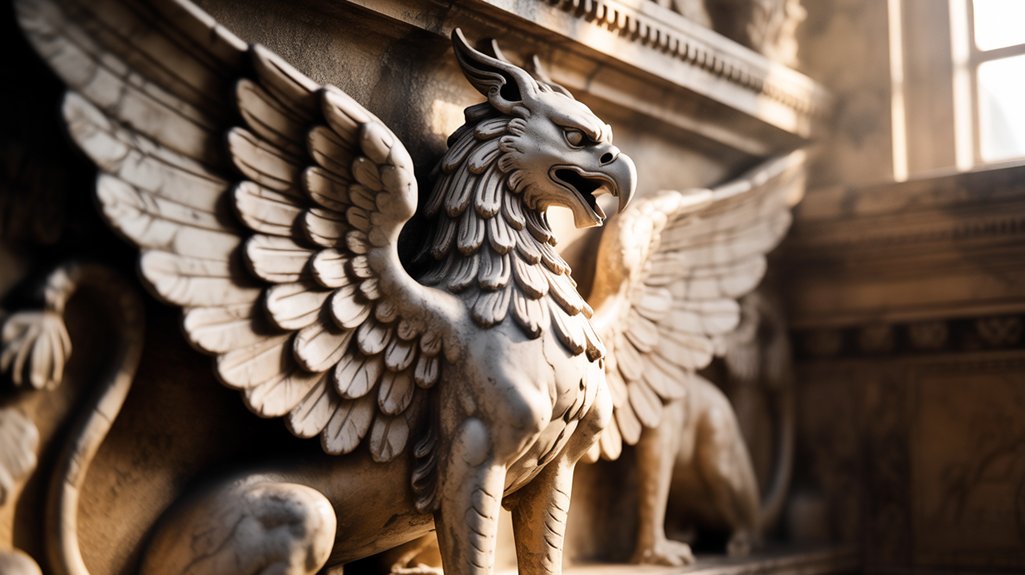
As digital screens flicker with reimagined tales of ancient wrath, contemporary media reshapes mythical fury into profound psychological allegory—dragons no longer serve merely as eldritch harbingers of destruction but emerge as chimeric representations of humanity’s most turbulent emotional depths.
You’ll witness this alteration across multiple platforms, where mythical anger becomes the vessel through which creators explore emotional narratives that question authority, challenge conventional morality, and celebrate individual autonomy.
Modern adaptations reveal fury’s true complexity:
Contemporary retellings transform mythical rage from simplistic destruction into layered psychological territory—your chaos given narrative form and philosophical weight.
- *Game of Thrones*’ dragons embody both devastating rage and transformative power, mirroring your own capacity for destruction and growth
- *How to Train Your Dragon* reframes mythical anger as misunderstood vulnerability, demanding empathy over conquest
- *God of War* weaponizes divine wrath as playable experience, forcing you to confront moral consequences
- These reimaginings liberate ancient archetypes from dogmatic interpretations, offering new frameworks for understanding your emotional sovereignty
Through these contemporary lenses, mythical fury transcends mere spectacle—it becomes your mirror, reflecting the eternal struggle between primal emotion and conscious choice.
Neuroscience of Emotional Archetype Processing
Neural pathways illuminate like ancient constellation maps when your mind processes these archetypal figures—your anterior cingulate cortex blazes with recognition as dragons materialize in narrative space, while prefrontal networks weave moral calculations through encounters with chimeric guardians and wrathful deities.
This neurological dance reveals your innate capacity to translate mythical symbolism into emotional wisdom, altering eldritch beings into mirrors of your deepest conflicts.
fMRI scans expose how these creatures activate your brain’s reward circuitry, reinforcing moral frameworks through symbolic encounters. Your neural architecture craves these archetypal shortcuts, processing centuries of accumulated wisdom in milliseconds.
When you imagine confronting a hydra or negotiating with sphinxes, you’re not escaping reality—you’re exploring it through concentrated emotional resonance.
Therapeutic applications utilize this neurological truth. Patients articulate previously inexpressible fears by channeling them through mythical forms, their brains building bridges between abstract emotion and concrete archetype.
This isn’t mysticism. It’s measurable neural plasticity, ancient knowledge validated through modern science.
Modern Therapy Uses Ancient Myths
When therapists invite clients to name their anxiety as a dragon coiled beneath their ribcage, they’re activating therapeutic mechanisms older than Freud’s consulting room—techniques that shamanic traditions perfected millennia before clinical psychology emerged as formal discipline.
Narrative therapy practitioners recognize that therapeutic symbols function as bridges between conscious articulation and subconscious recognition, allowing you to externalize what feels internally overwhelming. The phoenix becomes your metamorphosis. The chimeric beast embodies your fragmented identity.
Jungian-influenced psychologists understand these mythic narratives as repositories of archetypal wisdom, universal patterns that bypass cognitive defenses to access deeper relational wounds.
When you visualize your personal mythology—perhaps casting fear as an eldritch entity haunting liminal spaces—you’re not engaging in mere metaphor. You’re participating in humanity’s oldest healing technology, one that reshapes inchoate emotional chaos into coherent story.
This process restores agency, converting you from passive victim of incomprehensible feelings into active protagonist traversing recognizable mythological terrain. Ancient wisdom meets contemporary practice.
Integrating Myth With Morality
The Minotaur’s labyrinth wasn’t merely architectural—it was ethical topology, a physical manifestation of moral entanglement where Theseus confronted not just a beast but the civilizational shadow of Athenian tribute and Cretan hubris.
You’ll find that mythical archetypes function as compressed moral philosophy, delivering ethical frameworks through visceral encounter rather than abstract principle. When Heracles wrestled the Nemean Lion circa 1200 BCE, he wasn’t performing heroics—he was embodying humanity’s struggle against primal rage, that eldritch force threatening social cohesion.
These chimeric figures teach through paradox. Dragons hoard gold yet guard change’s threshold. Sphinxes destroy travelers yet illuminate self-knowledge’s price.
You’re invited to recognize your shadow-self within these monsters, to acknowledge that moral lessons emerge from integration, not annihilation. The creature you fear contains wisdom you’ve disowned.
Ancient Greece understood what modern liberation movements rediscover: freedom requires confronting internalized oppression, those labyrinthine passages where you’ve imprisoned your authentic power.
Frequently Asked Questions
How Do Children First Learn to Interpret Mythical Creatures Emotionally?
You first decode mythical creatures through imaginative play, where dragons become vessels for fear and phoenixes embody resilience.
Storytelling influence shapes your emotional lexicon—eldritch beings whispered by caregivers teach boundary and consequence.
Through these chimeric forms, you explore forbidden territories: anger through rampaging minotaurs, compassion through protective sphinxes.
Ancient narratives grant you freedom to externalize internal turmoil, transmuting abstract emotion into tangible form.
The creature becomes mirror, teacher, shadow—liberating you from linguistic constraints while mapping your expanding moral universe.
Which Mythical Creatures Specifically Represent Positive Emotions Like Joy or Love?
You’ll find salvation in creatures born from humanity’s deepest yearning for transcendence.
The unicorn symbolism radiates pure love—medieval bestiaries described its horn purifying poisoned waters, its appearance reserved for the virtuous.
Eastern dragons embody communal joy, their serpentine forms dancing through spring festivals.
Yet it’s the phoenix rebirth that captures hope’s essence: emerging from ash, wings ablaze, promising renewal.
These beings aren’t mere fantasy—they’re your ancestors’ emotional cartography, mapping pathways toward liberation through mythic truth.
Do Different Age Groups Interpret Mythical Creature Symbolism Differently?
Your age perceptions fundamentally reshape how you decode chimeric symbolism—children embrace dragons as wonder incarnate, while you, in adulthood, recognize their eldritch duality of destruction and wisdom.
Cultural influences compound this metamorphosis; ancient oral traditions transmitted through generations carry different resonances for youth versus elders who’ve weathered life’s trials.
You’ll find adolescents gravitating toward rebellious phoenix imagery, whereas maturity reveals deeper allegorical layers—transformation through suffering, resurrection through acceptance.
Your experiential lens determines symbolic revelation.
How Have Digital Games Changed Our Emotional Connection to Mythical Creatures?
Digital games have altered your relationship with mythical beings through unprecedented virtual interactions, allowing you to inhabit dragons’ perspectives, battle alongside griffins, forge bonds with phoenix companions.
This immersive emotional engagement transcends passive observation—you’re no longer distant scholar but active participant in eldritch narratives.
Yet something ancient diminishes: the chimeric uncertainty, the sacred mystery. You’ve gained agency, lost reverence.
These pixelated encounters offer liberation through control, simultaneously severing primal connections rooted in awe, fear, unknowing.
Can Creating Personal Myths Help Individuals Process Their Own Moral Dilemmas?
You’ll find that personal mythology acts as mirror to soul—ancient shamans knew this truth.
When you craft chimeric narratives embodying your conflicts, you’re engaging in moral reflection that transcends rational analysis. Your invented myths become vessels for ethical quandaries you can’t otherwise articulate. Liberation emerges.
Through archetypal patterns and eldritch symbolism, you’ll externalize internal struggles, converting abstract dilemmas into tangible tales. This sacred practice, documented across cultures from Mesopotamian scribes to Celtic bards, grants you sovereignty over your moral landscape.
Conclusion
You’ve traversed domains where humanity’s shadow-self materializes in eldritch form—where wrath becomes deity, where transgression births the chimeric. These ancient narratives don’t merely *describe* our darker inclinations; they transmute psychic turmoil into tangible archetype. Through Mesopotamian clay tablets and Hellenic tragedy alike, you’ve witnessed how civilizations metabolize moral rupture. The boundary dissolves. Your neurological pathways respond to millennia-old symbols as contemporary therapeutic modalities now recognize: myth remains humanity’s most sophisticated technology for processing what we’d rather leave unspoken.

